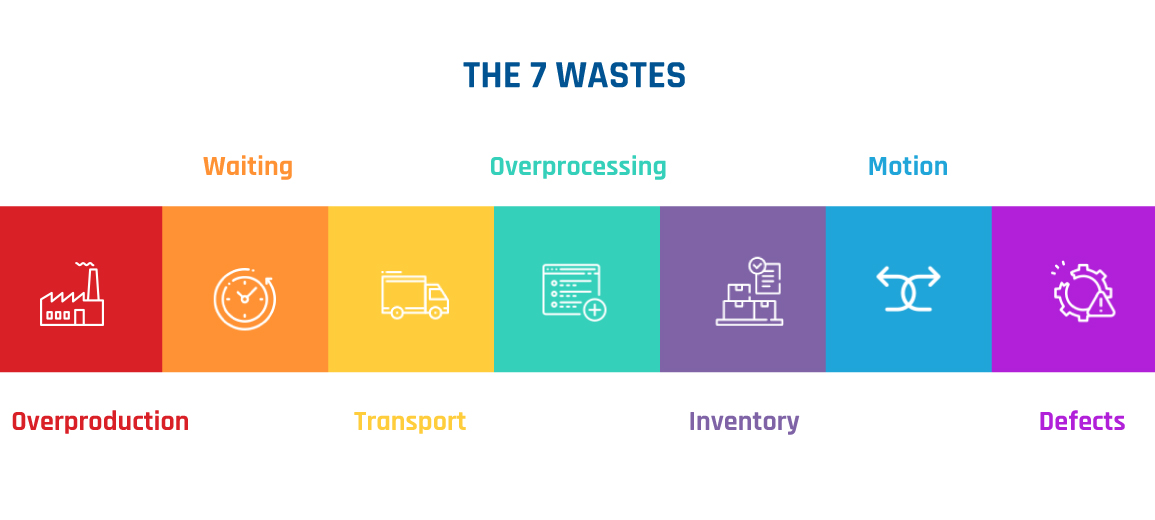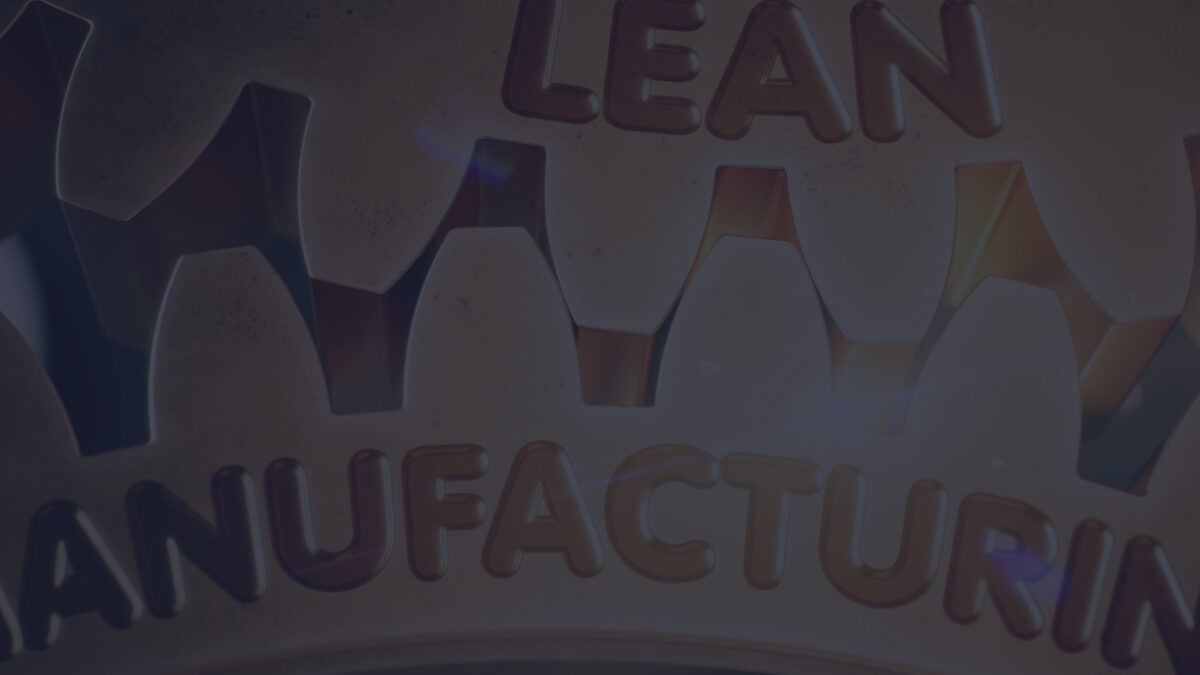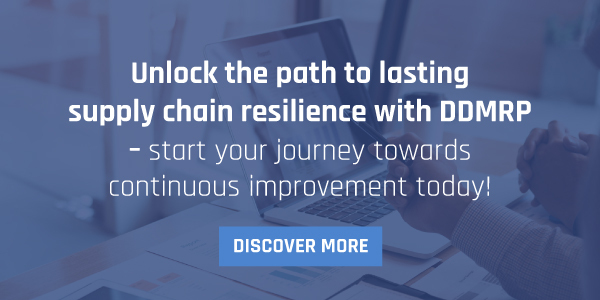
Advanced DDMRP Planning: Strategies for Efficient Inventory Management
December 11, 2023
Dynamic Supply Chains with DDMRP: Adapting to Demand Fluctuations
January 8, 2024The modern manufacturing landscape is increasingly complex and dynamic, demanding solutions that can adapt to rapid changes and uncertainties. Demand Driven Material Requirements Planning (DDMRP) and Lean Manufacturing have emerged as influential methodologies in this context. This article will explore how the integration of DDMRP with Lean Manufacturing principles can lead to production excellence.
Evolution of Manufacturing Planning
The evolution of manufacturing planning mirrors the changing needs and complexities of production environments over the years. In the early 1960s, inventory management was the cornerstone of manufacturing planning, focusing primarily on maintaining adequate stock levels to meet production requirements. This approach, however, had its limitations, especially as markets expanded and product diversities increased.
By the 1970s, the industry witnessed a significant shift with the introduction of Material Requirements Planning (MRP). MRP represented a more sophisticated approach, calculating material requirements based on end item demand, thus allowing for better resource and material allocation. Yet, MRP relied heavily on accurate demand signals and predictable lead times. With time, lead times became longer forcing the use of forecasts, leading to either over- or understocking and misallocation of capacity due to demand variability.
The advent of Demand Driven Material Requirements Planning (DDMRP) marks the latest phase in this evolution. DDMRP addresses the shortcomings of traditional MRP by introducing a more flexible, responsive approach. It combines aspects of MRP, Distribution Requirements Planning (DRP), Lean Manufacturing, and the Theory of Constraints to create dynamic inventory buffers. These buffers are designed to decouple the lead time and absorb variability, leading to more stable and reliable production plans. Unlike traditional safety stocks in MRP systems, DDMRP’s stock buffers are intended to adapt to both supply and demand fluctuations, reducing the bullwhip effect and enhancing supply chain responsiveness.
Understanding DDMRP
Demand Driven Material Requirements Planning (DDMRP) represents a significant advancement in manufacturing planning by integrating the strengths of Material Requirements Planning (MRP), Distribution Requirements Planning (DRP), Lean Manufacturing, and the Theory of Constraints. This methodology shifts the focus to a Demand Driven model, where actual sales orders and consumption patterns form the basis of planning, rather than relying on forecasts that may not accurately reflect current market realities.
Central to DDMRP is the concept of dynamic stock buffers. These buffers are strategically placed throughout the supply chain to absorb demand and supply variability. This flexibility contrasts sharply with traditional MRP systems, which often use static safety stocks that do not adapt to changing conditions. These fixed safety stocks in MRP systems are not intended to be consumed, leading to variability being passed to the supplying processes and thus generating inefficiencies such as overstocking or stockouts. DDMRP’s dynamic buffers, however, are meant to be consumed to absorb variability and are continually adjusted based on real-time demand and supply conditions, ensuring that inventory levels are more aligned with actual needs.
By adopting a pull-based approach to inventory replenishment, DDMRP effectively reduces the bullwhip effect – the phenomenon where small fluctuations in demand at the retail level cause increasingly larger fluctuations up the supply chain. This approach ensures that production and stocking decisions are made closer to the actual consumption time, thus significantly enhancing the responsiveness and agility of the supply chain.
The adoption of DDMRP represents a paradigm shift in manufacturing planning. It moves away from the traditional forecast-driven planning models towards a more responsive, flexible system that can better cope with the complexities and volatilities of modern supply chains. This shift not only leads to more stable and reliable production plans but also contributes to overall supply chain efficiency and effectiveness.
Lean Manufacturing Principles
Lean Manufacturing is designed to enhance manufacturing efficiency by minimising waste and maximising value. At its core, Lean focuses on identifying and eliminating non-value-adding activities in production processes, thereby streamlining operations and improving product quality.
The principle of waste reduction in Lean targets seven types of waste: overproduction, waiting, transport, overprocessing, inventory, motion, and defects. By systematically identifying and eliminating these wastes, Lean Manufacturing enhances operational efficiency and responsiveness to customer demands.
Continuous improvement, or ‘Kaizen’, is another central tenet of Lean. This approach fosters a culture of ongoing, incremental enhancements in every aspect of manufacturing, from workflow to employee skill sets. It encourages a proactive stance towards problem-solving and process optimization, ensuring that improvements are sustained and built upon over time.
Value stream mapping, a key Lean tool, involves a detailed analysis of the flow of materials and information through the entire production process. By mapping out each step from raw material to finished product, organisations can identify bottlenecks, redundancies, and opportunities for process refinement. This comprehensive view of the production process helps in creating a more efficient and effective flow, reducing lead times and costs while improving quality.
Lean Manufacturing is not just a set of tools and techniques; it’s a mindset that emphasises respect for people, collaboration, and customer focus. By involving employees at all levels in continuous improvement efforts and focusing on meeting customer needs, Lean drives a culture of excellence and innovation in manufacturing. This approach not only optimises production processes but also contributes to a more agile, adaptable, and competitive organisation.

Synergies between DDMRP and Lean Manufacturing
The integration of Demand Driven Material Requirements Planning (DDMRP) with Lean Manufacturing principles creates a powerful synergy that significantly enhances manufacturing efficiency. This combination leverages the strengths of both methodologies to optimise production processes, reduce waste, and improve responsiveness to market demands.
Traditional lean implementations are applied to the manufacturing shop floor. To be effective they require the shop floor to be insulated from external variability such as supply disruptions and sudden demand shifts. In fact, many lean manufacturing companies suffer and complain about their lean effort being in big part nullified by the disruptive force of that variability.
DDMRP can support lean manufacturing by insulating the internal production from disruptive external events, and thus creating the conditions for an effective lean manufacturing activity. On the other hand, lean manufacturing will allow for a better and more reliable flow of material through the shop floor, resulting in shorter and more predictable manufacturing cycle times. This will minimise the size of the DDMRP stock buffers, which are driven in big part by the reliability of the replenishment time.
The synergy between DDMRP and Lean Manufacturing goes beyond operational efficiencies. It fosters a more resilient and adaptable manufacturing environment. In a landscape characterised by volatility and rapid changes, the ability to quickly respond to market fluctuations is crucial. The integration of DDMRP’s Demand Driven approach with Lean’s waste reduction and continuous improvement ethos creates a robust framework for achieving manufacturing excellence in the modern era.

Implementing DDMRP in a Lean Environment
Implementing Demand Driven Material Requirements Planning (DDMRP) within a Lean Manufacturing environment necessitates a strategic approach that encompasses training, cultural adaptation, and process alignment. This integration demands an understanding that goes beyond mere technical know-how; it requires a shift in the organisational mindset towards a more dynamic, responsive way of managing inventory and production.
Effective training is pivotal in this transformation. Employees at all levels should be educated on the principles and practices of DDMRP, ensuring that they understand how it complements and enhances the existing Lean processes. This training should not only cover the technical aspects but also emphasise the importance of a Demand Driven approach in today’s volatile market landscape.
A cultural shift is equally important. Lean Manufacturing cultures typically value continuous improvement and efficiency; introducing DDMRP requires reinforcing these values while promoting adaptability and responsiveness to real-time market demands. Employees should be encouraged to embrace the dynamic nature of DDMRP, understanding how it aids in making more informed, data-driven decisions.
Aligning DDMRP processes with existing Lean workflows is crucial for seamless integration. This alignment involves configuring DDMRP’s dynamic stock buffers to align with Lean production and waste reduction strategies. Ensuring this alignment requires careful planning and a deep understanding of both DDMRP and Lean methodologies.
Monitoring the impact and success of DDMRP within a Lean framework requires the establishment of relevant Key Performance Indicators (KPIs) and metrics. These should include measures of inventory turnover, lead times, on-time delivery, and customer satisfaction. Regularly tracking these KPIs helps in assessing the effectiveness of the DDMRP implementation and identifying areas for further improvement.
Challenges and Considerations
Integrating Demand Driven Material Requirements Planning (DDMRP) with Lean Manufacturing is a natural progression for organisations already practising Lean principles, as the two methodologies complement each other well. The transition to DDMRP within a Lean context is relatively smooth, given their cultural similarities, although there are some nuances to consider.
Mindset Adaptation: While DDMRP and Lean share common goals of efficiency and waste reduction, DDMRP introduces a nuanced shift in perspective, particularly concerning inventory management. Lean practitioners, who often view any inventory as undesirable, may need to adapt to the idea that strategic inventory levels, as advocated by DDMRP, can be beneficial. This adaptation is more about refining existing principles rather than a wholesale cultural shift.
Complementary Integration: DDMRP seamlessly aligns with the Lean approach, enhancing its capabilities. DDMRP’s focus on demand-driven planning enriches Lean’s just-in-time principles, offering a more dynamic response to real-time demand and supply conditions. This integration leverages the strengths of both methodologies, leading to improved operational efficiency.
Reduced Change Management Effort: Organisations already practising Lean will find that incorporating DDMRP requires less effort in change management compared to those unfamiliar with Lean principles. The foundational understanding and practices of Lean provide a solid base for integrating DDMRP’s strategies, resulting in a smoother transition and less resistance among employees.
Education and Training: A successful integration requires significant investment in education and training. Employees at all levels need to understand how DDMRP works and how it complements Lean principles. This training should be ongoing to accommodate updates in methodologies and ensure continuous improvement.
Technology Integration: Integrating DDMRP into existing IT infrastructure can pose challenges. Organisations need to ensure that their technology systems can support DDMRP’s dynamic nature, including the capability to adjust to real-time demand signals and manage dynamic stock buffers effectively.
Conclusion
The integration of Demand Driven Material Requirements Planning (DDMRP) with Lean Manufacturing principles marks a significant advancement in the field of production and supply chain management. This synergy offers a comprehensive approach to addressing the complexities of modern manufacturing environments. By combining the dynamic, Demand Driven focus of DDMRP with the waste reduction and efficiency principles of Lean, organisations can achieve a more responsive, agile, and efficient production system. However, the journey towards this integration is not without challenges. It requires some shifts in organisational culture, adoption of new methodologies, and integration of novel planning systems. Embracing these changes enables organisations to navigate the volatile and demanding market landscape effectively, leading to sustainable growth and operational excellence.
Explore the synergy between DDMRP and lean manufacturing to achieve operational excellence in production!





